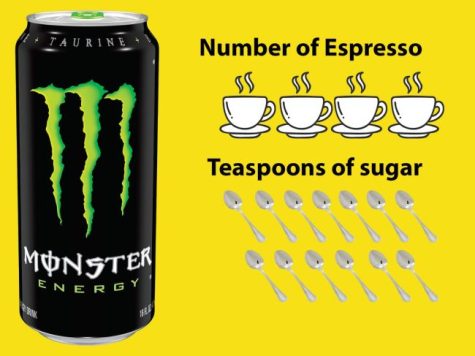Growing popularity of energy drinks threatens lives and causes irreparable damage
Energy drinks’ growing popularity has caused serious harm to humans. Heart damage, anxiety, and strokes have all been connected to energy drinks.
The main cause of side effects from energy drinks is the excessive amounts of sugar and caffeine. According to Mayo Clinic Health System, “One 16-ounce can of Monster Energy Juice Pacific Punch supplies 210 calories and 47 grams of added sugar, which is equal to roughly 12 teaspoons. This is an entire day’s worth of added sugar.”
 That much sugar can cause headaches, fatigue, heart disease, and diabetes if drunk regularly. Many people drink 1-5 energy drinks a day, which is potentially 5 times one’s recommended sugar intake.
That much sugar can cause headaches, fatigue, heart disease, and diabetes if drunk regularly. Many people drink 1-5 energy drinks a day, which is potentially 5 times one’s recommended sugar intake.
Math teacher Jaclyn Hastings says, “I think it’s gross how much sugar and caffeine is in it. I mostly stray away because of all the sugar, but the caffeine is definitely part of it too.”
According to an article from BetterHealth, too much caffeine can cause short-term effects like increased heart rate, dizziness and headaches, irritability, and restlessness. Caffeine can also cause a feeling of extreme energy, but then an even greater feeling of tiredness.
Once aware of all of these effects, band director Micheal Palermo states, “When my kids were young teenagers I absolutely didn’t let them drink them. The ‘benefits’ are not a risk I’m willing to take for myself or my children.” Palermo added, “It’s bad for any age. It’s absolutely horrendous for a 9-year-old to drink one because their body is still growing. But it’s bad for people 40 or older to drink with organs that are getting older.”

To back up what Palermo said, an article from NCCIH reads, “Caffeine also may harm children’s still-developing cardiovascular and nervous systems.”
Despite evidence of the risks, energy drinks are growing in popularity among younger consumers. The NCBI also notes, “Nearly two-thirds of teens reported ever using energy drinks; 41% had done so recently, i.e., in the past three months. Middle adolescents reported higher prevalence of both lifetime and recent use of energy drinks than early adolescents.”
One of the more relevant energy drinks is Celsius Liv Fit. Many people say the flavors have an amazing taste and give boosts of energy, but student Samantha Coburn has differing opinions.
When asked why she first started drinking Celsius, MMS eighth grader Samantha replied, “ I saw so many other people drinking them so I wanted to try them. They tasted really good but made me feel sick. I would get dizzy and a headache, so I stopped drinking them when I would get these symptoms and heard about people being hospitalized.”

Many teens feel pressured to consume energy drinks because they want to fit in with everyone, and the drinks have great-tasting flavors, which hide the underlying risks from the ingredients.
Typically, in energy drinks, the main ingredient for caffeine is a plant called Guarana. As stated in an article from NCBI, one guarana bean holds 4 times as much caffeine as one coffee bean.
As stated before, caffeine has been related to heart rhythm disturbances and raised blood pressure. Along the same lines, it states in an article written by Harvard Health, excessive sugar intake can cause health issues such as inflammation.
Believe it or not, the amount of caffeine in these drinks is enough to cause withdrawal.
Micheal Palermo agrees with this statement and says, “People rely on energy drinks way too much.”
According to BetterHealth, symptoms such as crankiness, persistent headaches, and muscle pain all occur if you depend on energy drinks, and then stop drinking them.
Energy drinks can have so many consequences. Everyone should take the health risks of energy drinks into consideration before consuming one. 







